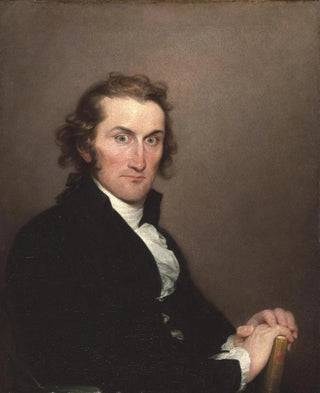Art print | Dr Lemuel Hopkins - John Trumbull


View from behind

Frame (optional)
The artwork "Dr Lemuel Hopkins" by John Trumbull is much more than a simple portrait; it is an open window into 18th-century America, a time when art and politics intertwined to shape the identity of a nascent nation. In this painting, Trumbull succeeds in capturing not only Dr Hopkins's features but also the essence of a man engaged in the struggles of his era. The subject's penetrating gaze, combined with a thoughtful composition, invites the viewer to delve into the complex universe of the American Revolution. This portrait embodies a pivotal period, where every detail, from the costume to the posture, tells a story of dedication and service to the homeland.
Style and uniqueness of the artwork
Trumbull's style is distinguished by its precision and attention to detail, characteristic of neoclassicism. In "Dr Lemuel Hopkins," each brushstroke is meticulously designed to create an atmosphere of dignity and respect. The colors, both rich and subtle, add emotional depth to the painting, while light plays a crucial role in highlighting Dr Hopkins's facial features. The latter, representing a man of science and medicine, is depicted in a posture that suggests reflection and authority. The background, though understated, serves to emphasize the central figure, thus reinforcing the importance of the character within the historical context. Trumbull manages to transcend the simple portrait by offering a reflection on the role of intellectuals and physicians during a period of upheaval.
The artist and his influence
John Trumbull, often nicknamed the "painter of the Revolution," is an iconic figure in American art history. Trained at Yale University before continuing his studies in Europe, he was heavily influenced by European masters while developing a style that is uniquely his own. His works, which often highlight significant events in American history, have played a crucial role in shaping the visual identity of the United States. Trumbull not only documented his era but also contributed to historical narration through his art. His ability to capture the spirit

Matte finish

View from behind

Frame (optional)
The artwork "Dr Lemuel Hopkins" by John Trumbull is much more than a simple portrait; it is an open window into 18th-century America, a time when art and politics intertwined to shape the identity of a nascent nation. In this painting, Trumbull succeeds in capturing not only Dr Hopkins's features but also the essence of a man engaged in the struggles of his era. The subject's penetrating gaze, combined with a thoughtful composition, invites the viewer to delve into the complex universe of the American Revolution. This portrait embodies a pivotal period, where every detail, from the costume to the posture, tells a story of dedication and service to the homeland.
Style and uniqueness of the artwork
Trumbull's style is distinguished by its precision and attention to detail, characteristic of neoclassicism. In "Dr Lemuel Hopkins," each brushstroke is meticulously designed to create an atmosphere of dignity and respect. The colors, both rich and subtle, add emotional depth to the painting, while light plays a crucial role in highlighting Dr Hopkins's facial features. The latter, representing a man of science and medicine, is depicted in a posture that suggests reflection and authority. The background, though understated, serves to emphasize the central figure, thus reinforcing the importance of the character within the historical context. Trumbull manages to transcend the simple portrait by offering a reflection on the role of intellectuals and physicians during a period of upheaval.
The artist and his influence
John Trumbull, often nicknamed the "painter of the Revolution," is an iconic figure in American art history. Trained at Yale University before continuing his studies in Europe, he was heavily influenced by European masters while developing a style that is uniquely his own. His works, which often highlight significant events in American history, have played a crucial role in shaping the visual identity of the United States. Trumbull not only documented his era but also contributed to historical narration through his art. His ability to capture the spirit






